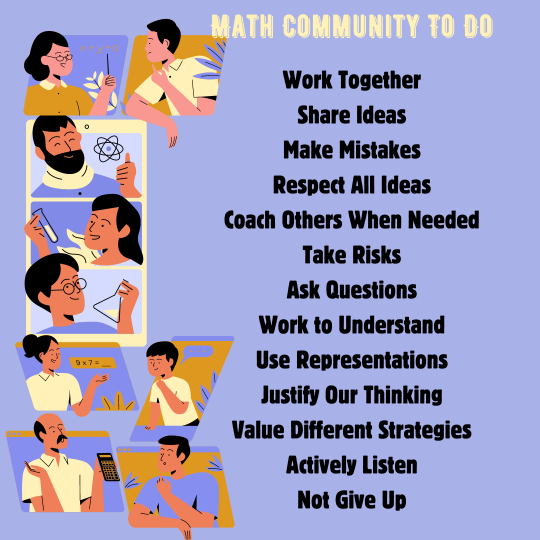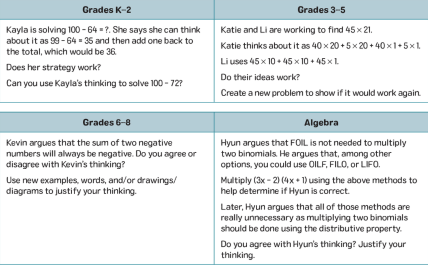The Struggle
If you struggled with math at any point in your school years, this conversation is for you
 Traditional pedagogical approaches to mathematics often present the subject as a rigid collection of formulas and procedures, leading to a perception of math as cold, unforgiving, and anxiety-inducing. This perspective fosters a culture of "learned helplessness" where students become discouraged by challenges and view mistakes as failures.
Traditional pedagogical approaches to mathematics often present the subject as a rigid collection of formulas and procedures, leading to a perception of math as cold, unforgiving, and anxiety-inducing. This perspective fosters a culture of "learned helplessness" where students become discouraged by challenges and view mistakes as failures.
Struggle is a good thing! It means your brain is working hard to form new connections. This growth mindset reframes struggle as a natural and crucial part of the learning process. Also, everyone will face struggle at some point. Structure struggle as a normal part of the process as early as possible and later when the struggle appears, the student won't mistake struggle for failure. Allowing time for struggle ensures authentic interactions with the material.
Acknowledge and celebrate the making of mistakes - mistakes are stepping stones. Embracing mistakes as valuable learning opportunities allows students to experiment with different approaches, fosters critical thinking and perseverance. This includes examining mistakes to figure out what happened and realizing that mistakes are often an answre to a different question. It also means not getting demoralized by mistakes, not letting mistakes dictate your worth, and not letting mistakes create a limit to what you can and cannot understand.
Why create a 'community'? Work together. A focus on collaboration leverages the power of diverse perspectives. By working together, students encounter a multitude of problem-solving strategies, fostering a richer understanding and the potential for truly creative solutions. The problem with building a community is that it takes time to build trust between the individuals and the teacher, time and dedicated efforts. Even if you are working with your own kids on the mathematics, it is extremely valuable that they see your time together as collaborative efforts, a place of safety to make mistakes of a mathematical nature and to sit together to figure out the problems.
How To Create A Math Community
Step 1 Mathematical Identity
- Build a mathematical identity - like a super hero alter ego
- Examine your own relationship to mathematics, so that you don't add (even subconsciously) or create a negative atmosphere
- Discuss importance of encouraging/promoting identities for productive healthy dispositions about math AND for productive struggle
- Familiarize yourself with your student, specifically how they engage or avoid productive struggle (for example - making jokes, breaking pencils vs walking around, using a calculator)
- Start a math autobiography - allowing students to define themselves
- A math journal - something that changes with the child
- A math zine - could be done in collaboration
Step 2 Community
Understanding the characteristics of communities (from Productive Math Struggle)
- Establish norms of behavior and interaction
- Trust among members
- Relationships based on knowing and respecting individuals
- Acceptance, belonging and support
- Common understanding of the value of struggle
How to build and cultivate this:
![]() Activity! Introduce
Introduce the ideas -
Activity! Introduce
Introduce the ideas -
- Talk about what you expect the child to do in a given situation (ie - when you have a problem you find particularly difficult, first visualize the problem by drawing it out or writing it out).
- Talk about the problem. By explaining the problem to someone, sometimes you discover the answer yourself, or find some flawed logic or error that is keeping you from finding the answer.
- Encourage - remind yourself that making mistakes is part of the process and that the uncomfortable feelings are there, annoying as they are, to push you to keep trying to figure it out.
- Talk about when it is okay to seek help - and how to do it.
![]() Activity! Affirmation
Activity! Affirmation
Child creates posters, illustrates example, writes in journal about specific topics, simply discuss > this creates ownership for the students - Download affirmation and cards from Maker
![]() Activity! Picture of Struggle
Activity! Picture of Struggle
Ask students to bring a picture they associate with struggle. Talk about 'good' and 'bad' struggle. Ask about feelings and behaviors that are connected with struggle (ie sitting alone, hair pulling, working together, frustration, sorrow...)

![]() Activity! Reflect
Activity! Reflect
Engage periodic reflection on and celebration of efforts and struggle
![]() Activity! Maintain
Activity! Maintain
Taking the time to build and maintain community so students are actively engage in math, discussion and struggle - means less time teaching the content itself (because this leads to actual engagement with the material, and what is understood is not forgotten)
![]() Activity! Community Pledge
Activity! Community Pledge
By pledging you promise, and by a promise students are asked to state their intentions. Short and co-created makes for the best pledges. Discuss the ideas, so that pledge is as complex as the students can handle, fully fleshed out and meaningful (use math community to do list for ideas). As you add ideas to you pledge, ask children to say what their idea of 'good' and 'bad' group might be.
![]() Activity! Community Number Quilt
Activity! Community Number Quilt
Let each child make 4-6 quilt squares out of cardboard, 4 x 4. On the one side, a number that represents them in some way, on the other a picture to go with the number (ie 3 and a picture of a goldfish, meaning I have three pet goldfish). Place the squares on the a large sheet of paper so that the squares can be lifted to show the picture on the back (numbers on the front). Discuss the squares and what they mean.
![]() Activity! Community Number Pictures
Activity! Community Number Pictures
Ask children to bring in a picture that is meaningful to them and write numbers to describe the picture. Talk about the pictures and what the numbers mean, in relation to the picture. See figure 3.6 in the Productive Math Struggle book for an example.
![]() Activity!
Community Block - Dimensions of Me
Activity!
Community Block - Dimensions of Me
Create a paper block. On each face place a 'role' of the student on to each side of the cube - common and uncommon interests, values, hobbies, and so on. Use the cube as a conversation starter in small groups, role the cube and talk about the words or images.
Step 3 Math Goals
Goal of mathematics lessons should allow for students to make sense of the problem and to struggle while doing so. Mathematics ideas and language should amplify rather than simplify - instead of water-downed versions of concepts, all students should have a chance to be challenged by the problem, encouraged to discuss it, and to pass through the struggle to a probable solution. Good tasks expose misconceptions or underdeveloped ideas, enable discussions to unpack and correct or enhance ideas.
What to keep in mind when planning a math lesson:
- Experience with similar tasks
- Understanding prerequisite or related skills and concepts
- Confidence in math
- Participation in conversation and supports to enhance it
- Comfort taking risks, trying new or different strategies
- Computational fluency and tools to support it
Math goals that incorporate struggle Original Lesson Plan:

First the teacher shows how to do it, then you practice it yourself
With Struggle:

Allow students to try and solve it themselves. Wonder, how will they fill in the third box? By struggling, they will have to define what it truly means to be a decimal. Only then, can they fill in the third block.
Check your instruction over the course of a unity of study focuses equally on promoting
- Conceptual understanding means students access concepts from different perspectives and through connections to other ideas - Students need to grapple while examining representations, patterns, relationships, and form and test theories as their assumptions and understandings grow. This isn't something you can 'tell' or 'show' - it must be 'discovered.'
Adjusting numbers when subtracting Using partial products when multiplying Sums of negative numbers Simplified quadratic equations

each task is presented with 'proof' that is works, and students are tasked with making sense of the idea, determining if it always works.
- Procedural fluency means the ability to apply specific, known steps or procedures to complete a calculation or comparison. Fluency with procedures refers to efficiency and accuracy with which they are applied. It includes: conversations, solving for the knowns, finding the area of a rectangle or comparing fractions/ratios. Fluency is developed through practice, but acquired through conceptual understanding. Fluency is about practice, but 5 problems have more value than 25, when students show fatigue. Struggle also becomes unproductive when practice is initiated before students fully acquire the procedure or fail to use it consistently. Premature introduction might lead to misconceptions.

- Capacity for application of skills and concepts
Often associated with one- or two- step word problems. Check students ability to apply what they learned by introducing a new type of problem that relies on procedures already learned. If students don't apply the procedures, they might not have fluency and/or conceptual understanding. These problems should test students' ability to:
- make sense of the problem
- consider how to represent it
- select a strategy to find a solution
- determine if their solution is reasonable

Balance Instruction that uses conceptual understanding, procedural fluency, and applied mathematics allows students to struggle in a positive way and are built on the fundementals of CRITICAL THINKING:
- Grapple with the topic
- Challenge your assumptions
- Consider alternatives
- Make sense of procedures
- Assimilate new strategies into existing collection
- Make your own meaning


